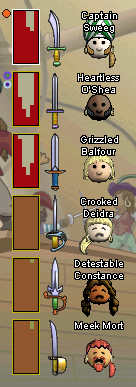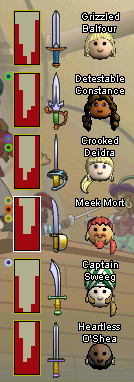Teaming
Teaming is an important skill in multi-player rumble and swordfighting puzzles such as sea battle and brawling. Both of these involve two groups fighting against each other with swords or bludgeons.
The term "teaming" refers to "ganging up" on your opponents, most typically in groups of two or three, depending on your play-style and preferences, and those of your team leaders.
The two teams

Your team will be on the left-hand side of your screen; your opponents will be on the right-hand side. If you are fighting with swords, each of the members of both teams will be illustrated with a rectangular box that serves as a miniature version of each pirate's puzzle window, (styled so that the colors of the placed pieces are hidden, at the very least until that player is knocked out) an image of the player's sword, and the pirate's face. If you are rumbling there is (obviously) no sword image; the pirates hands are displayed along with their faces instead, for the purposes of displaying the player's equipped bludgeon, if any.
Once the fight starts, there will be small, dual-colored dots that appear next to the mini puzzle windows of players from both teams. Each of these represents one pirate, and they indicate how many opponents are currently focused on that particular person. For example, if there are two dots next to your pirate's mini puzzle box, that would indicate that two of your opponents are attacking you. The exception to this is the large, orange dot. When teams become so large that there isn't enough room to display all of the dual-colored dots, five dots are combined into a large orange dot. Two large orange dots represent ten pirates, and so on. There is only enough room to display six of these large dots – which would be the equivalent of thirty pirates – but more than thirty pirates can still attack a single opponent, they just won't be visually represented.
The dots themselves are colored based on the two colors of each person's sword or bludgeon. If you happen to have a sword that is blue and purple, the dot that represents you will be a small purple dot surrounded by a blue circle, forming a dual-colored dot that is specific to you.
It's easy to know where your personal dot is residing, as the enemy you are currently focused on will have a white border around their puzzle overview box (as opposed to the orange border of all your other opponents' boxes). This allows you to see who you are focused on at any given moment, by looking over to the right-hand side of your screen.
The easiest way to tell if you are currently "teamed up" with someone else is to look at the list of enemies on the right-hand side of your screen, and find the tell-tale white border around the puzzle box of one of your opponents. In battles with several pirates on the opposing side, you may have to scroll the list of pirates to find the one you are currently focusing your attacks on. The goal of teaming is to have several of those dual-colored dots next to your opponent's puzzle box. If there is only one, then you are not teamed. Common wisdom dictates that the ideal team size in swordfighting is three (because above that, bots generally start stalling). In Rumble, larger teams of four or five seem to be more effective.
Switching from one enemy to another is simple; once you have located an enemy that you wish to target, use your mouse to click on their face, or the miniature puzzle box next to their head. You may scroll through the enemies using the keys "page up" and "page down", "A" and "S", "[" and "]", or the mouse wheel. Once you have successfully targeted an enemy, their rectangular puzzle box will display a white border, and your personal dot will be located next to their puzzle box, along with the dots of any of your team-mates who were already attacking that enemy.
Re-teaming
Once the enemy that you are targeting has been knocked out, the focus of your attacks will be moved to one of your remaining enemies at random. Because of this, it is important to regularly glance at the list of your opponents and make sure that you are still teamed up. If you find yourself suddenly alone, you will need to "re-team" by selecting a new opponent.
Every time a player is knocked out of the battle, an audio alert will sound and a text notification of the defeat will briefly display across your puzzle area. Quickly glancing to your opponent list when this happens to make sure that you are still teamed up can be an excellent habit to cultivate.
Teaming preferences
Specific instructions on how to team will often be given to you by other players, such as a pillage leader giving directions to the pirates who are jobbing with them. These instructions may be as simple as a reminder to stick to teams of two or three pirates whenever possible; or they may be more advanced requests, such as instructing pirates to focus on a specific opponent, a certain type of opponent, (such as attacking yellow-named player pirates before focusing on white-named swabbies) or asking players to attack certain types of swords first. (This often manifests as an instruction to attack the more powerful swords – typically cleavers, skull daggers, and scimitars – or, alternately, the less-powerful swords, which many believe possess increased instakilling tendencies, when wielded by non-player "bot" pirates.)
Some players have been known to suggest teaming in ways that many feel are based on superstition, such as teaming on pirates who are wearing hats – or teaming on certain skellies, based on the color of their bones – because these enemies are perceived to be harder to beat, and therefore important to knock out early in the fight. Both of these criteria (hats and color) have been largely disproven by the player community; these bots are no harder than any others.
As such, while it is considered good practice to obey the instructions of your captain or team leader, it is also a good idea to consider the source of your information when deciding how to best combine your efforts with your teammates.
Defending your teammates
In a rumble battle, it is possible to defend one of your teammates. If you choose to do this, however, you will stop attacking the opposing team for as long as you are defending a pirate. You can only choose one pirate to defend at a time, and each pirate can only be defended by one pirate at a time.
To defend someone, you select one of your teammates – instead of an enemy – by clicking on them. When you do this, your dot will disappear from the list of your opponents, and a blue bar will appear above the puzzle box of the teammate you have chosen to defend. As you send attacks in your puzzle, this blue bar will grow in size, giving you a visual representation of your defensive capabilities. Attacks sent to the pirate who is being defended will decrease the size of this defense bar, and some of the attacks that were directed at them will be sent to you, instead.
Because the dots of anyone serving as defense will disappear from your opponent list, the other team may be able to tell that some pirates are being defended, by counting the number of visible dots. However, only the members of your team will be able to see who is being defended. Likewise, you will not be able to see who (if anyone) is being defended on the opposing team.
If you need to stop defending and begin attacking your opponents again, simply choose an enemy from the list, and switch your focus back to the other team.

